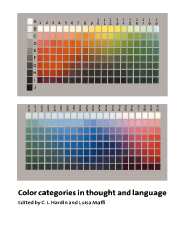Book contents
- Frontmatter
- Contents
- Notes on contributors
- 1 Introduction
- I THE WORLD COLOR SURVEY
- II VISUAL PSYCHOLOGISTS
- 3 The psychophysics of color
- 4 Physiological mechanisms of color vision
- 5 The neuropsychology of color
- 6 Insights gained from naming the OSA colors
- 7 Beyond the elements: investigations of hue
- 8 Color systems for cognitive research
- III ANTHROPOLOGISTS AND LINGUISTS
- IV DISSENTING VOICES
- 16 Closing thoughts
- Subject index
- Author index
8 - Color systems for cognitive research
Published online by Cambridge University Press: 20 August 2009
- Frontmatter
- Contents
- Notes on contributors
- 1 Introduction
- I THE WORLD COLOR SURVEY
- II VISUAL PSYCHOLOGISTS
- 3 The psychophysics of color
- 4 Physiological mechanisms of color vision
- 5 The neuropsychology of color
- 6 Insights gained from naming the OSA colors
- 7 Beyond the elements: investigations of hue
- 8 Color systems for cognitive research
- III ANTHROPOLOGISTS AND LINGUISTS
- IV DISSENTING VOICES
- 16 Closing thoughts
- Subject index
- Author index
Summary
How many colors?
While some researchers claim that there are eleven basic colors, others claim that there are several million colors. By that I do not refer to the merry advertisements from the computer screen manufacturers promising 16 million colors (most of these have one and the same color: black), but rather to the number of colors (calculated – not counted) that the normal human eye can distinguish. If two identical surfaces are first presented adjacent to each other and then one of them is slightly varied until a “just noticeable difference” (jnd) can be seen, it is possible, by extrapolating from the stimulus difference to the entire “visible wavelength- and intensity-range,” to get an estimate of the number of possible color nuances. Whether these are 3 million or 10 million could only be of academic interest.
To arrive at this large number of distinguishable colors requires that the colors be juxtaposed. If we move them apart by even a few centimeters, the two color surfaces. which when juxtaposed are seen as clearly dissimilar, immediately appear identical. If we hold color samples even farther apart from each other rather large color differences are necessary if we are to see surfaces as different. Suddenly the number of perceptually distinct colors has dropped to a couple of thousand, or less.
Although it is an intricate task to determine just how many colors there are, even for a “normal observer,” we can at the very least state that there are many.
- Type
- Chapter
- Information
- Color Categories in Thought and Language , pp. 163 - 194Publisher: Cambridge University PressPrint publication year: 1997
- 32
- Cited by



